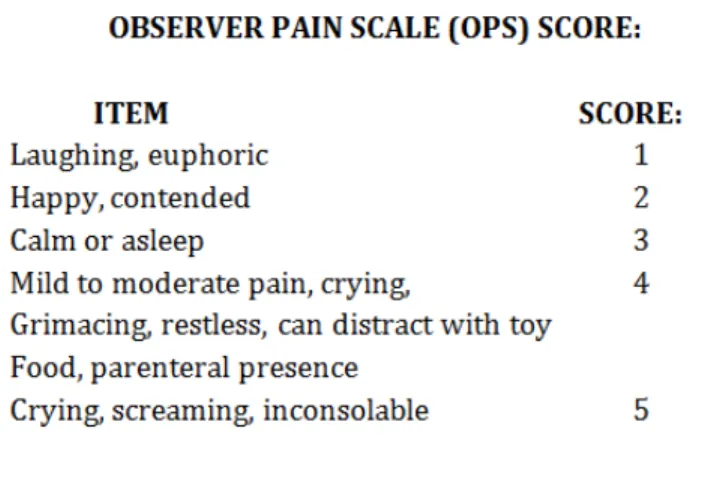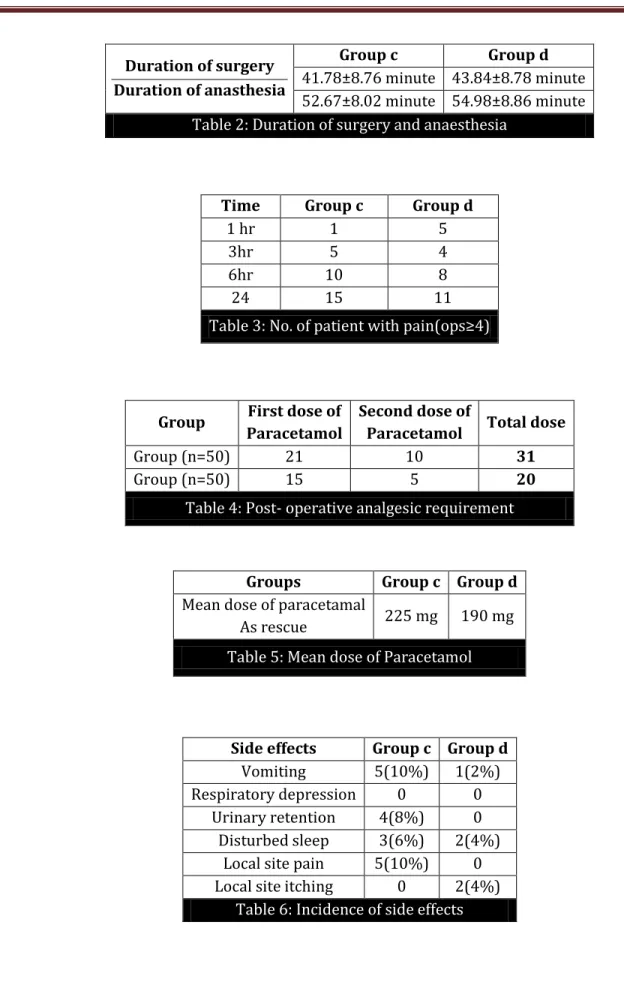A COMPARISON OF RECTAL DICLOFENAC WITH CAUDAL
LEVOBUPIVACAINE FOR POST OPERATIVE PAIN RELIEF IN CHILDREN
FOLLOWING LOWER ABDOMINAL OPERATION
Supriya De Ray1, Jayanta Chakroborty2, Dibyendu Roy3, Raj Mohan Ghosh4
HOW TO CITE THIS ARTICLE:
Supriya De Ray, Jayanta Chakroborty, Dibyendu Roy, Raj Mohan Ghosh. A Comparison of Rectal Diclofenac with Caudal Levobupivacaine for Post-Operative Pain Relief in Children Following Lower Abdominal Operation . Journal of Evolution of Medical and Dental Sciences 2015; Vol. 4, Issue 40, May 18; Page: 6920-6925,
DOI: 10.14260/jemds/2015/1005
ABSTRACT: INTRODUCTION: Pain is an unpleasant sensory and emotional experience. . Adequate pain relief reduces the stress response and pain relief through epidural route. Caudal epidural analgesia is very commonly practiced technique in children with levobupivacaine. Rectal administration of diclofenac in children is safe and convenient route and sustained action of this drug provides analgesia in early and late post-operative period. AIMS: The aim of the study is to compare post-operative analgesic effect of rectal diclofenac with caudal levobupivacaine. MATERIALS AND METHODS: Hundred children were allocated randomly in two groups in equal numbers using generated randomisation chart. All the patients underwent general anaesthesia. At the conclusion of surgery group A(n=50) received caudal injection of 1ml/kg of 0.25% levobupivacaine. The patients were put left lateral and 23 gauge 25 mm long, short bevelled needle was used for this purpose. Group B(N=50) received a suppository of diclofenac sodium 2.5mg/kg. All anaesthesia, caudal block and suppository insertion was performed by the same anaesthetist. No information on the method of analgesia or the study group to which the children belong was given to the ward nurse for post-operative observation. Syr. Paracetamol was as post-post-operative rescue analgesic as 15 mg/kg orally. The ward nurse assessed pain according to the observer pain scale. Assessment was undertaken in four occasions, 1, 3 and 6 hours post operatively and overnight. If the patient were comfortable without any complain, they were discharged in the in following morning after completion of 24 hours. RESULT AND ANALYSIS: Statistical analysis of the data for pain and use of post-operative analgesic was done by chi-square test analysis with yati s correction. )ntergroup comparision of parametricv data were made by using student unpaired t test. P<0.05 was considered to be significant.100 patients were grouped as Group C= caudal levobupivacaine and Group D=rectal diclofenac group. The number of patients who complain of pain in 1hr, 3hr, 6hr, 24 hrs is significantly low in the patients received rectal diclofenac. Mean dose of syr. Paracetamol required as rescue analgesic is statistically significantly low in Group D. CONCLUSION: Rectal diclofenac is a useful alternative to caudal bupivacaine and may affix advantages compared to caudal bupivacaine with regard to safety and convenience of use for post-operative pain relief in children.
KEYWORDS: Rectal diclofenac, caudal bupivacaine, children, lower abdominal operation.
Caudal epidural analgesia is very commonly practiced technique in children and rationale for replacing racemic bupivacaine with levobupivacaine is to provide wider margin of safety. Diclofenac sodium is a NSAID which inhibits cyclooxygenase enzyme and reduces intracellular concentration of free arachidonates in leucocytes. Rectal administration in children is safe and convenient route and sustained action of this drug provides analgesia in early and late post-operative period.
AIMS: The aim of the study is to compare post-operative analgesic effect of rectal diclofenac with caudal levobupivacaine.
MATERIALS AND METHODS: Informed written consent was obtained from the parents of 100 healthy children (ASA I OR II), aged between 1-5 years, body weight ranging from 5-15 kgs, no preponderance of sex, undergoing lower abdominal operation.
Children having history of allergic reaction to the study agent, bleeding diathesis, asthma, pre-existing neurological or spinal diseases, aspirin ingestion in the preceding week, hypovolumia of any cause, malformation of the sacral area i. e. spina bifida, infection in the local site excluded from the study.
Hundred children were allocated randomly in two groups in equal numbers using generated randomisation chart.
Premedication was given in the form of triclofos sodium 50 mg/kg orally, 2 hours before operation. Solid foods were not allowed after midnight and clear liquids were permitted up to 3 hrs before surgery.
After the patient arrived to the waiting area body weight and baseline hemodynamic data e.g., pulse rate, respiratory rate, percentage saturation of Hb, non-invasive blood pressure and temperature were recorded.
General anaesthesia was induced with induced with 66% nitrous oxide in 33% oxygen and halothen 2.3% via Jackson-Rees modification of Ayra s T piece and appropriate size face mask. A 22 gauge intravenous cannula was introduced in the dorsal vein of the hand of each patient. Atropine 0.01 mg/kg was given and monitors like pulse oximetry, NIBP, ECG, temperature probe were used. For intubation atracurium 0.5 mg/kg was used vand controlled ventilation was done. Inj. pethidine 1mg/kg intravenous was used as analgesic during intraoperative period. Inj. atracurium was repeated as required. At the conclusion of surgery group A(n=50) received caudal injection of 1ml/kg of 0.25% levobupivacaine. The patients were put left lateral and 23 gauge 25 mm long, short bevelled needle was used for this purpose. Group B(N=50) received a suppository of diclofenac sodium 2.5mg/kg. Residual neuromascular block was reversed with neostigmine 0.04 mg/kg and atropine 0.02mg/kg. All anaesthetia, caudal block and suppository insertion was performed by the same anaesthetist.
After recovery duration of surgery was noted and the child was transferred to the post-operative care unit with advice of moist nasal oxygen for 2 hours. Monitors were set up in the observation room. No operation lasted for more than 40 minutes. No information on the method of analgesia or the study group to which the children belong was given to the ward nurse for post-operative observation.
All patients received rescue analgesic at a time but no more than 3 times a day when observer pain scale was 4 or if the patient felt pain. Any side effect like nausea or vomiting was noted.
Assessment was undertaken in four occasions, 1, 3 and 6 hours post operatively and overnight. If the patient were comfortable without any complain, they were discharged in the in following morning after completion of 24 hours.
RESULT & ANALYSIS: Statistical analysis of the data for pain and use of post-operative analgesic was done by chi-square test analysis with yati s correction. )ntergroup comparision of parametricv data were made by using student unpaired t test. P<0.05 was considered to be significant.100 patients were grouped as Group C= caudal levobupivacaine and Group D= rectal diclofenac group.
Table 1 shows mean age of the patient of group c & group D was 2.2±0.69 and 2.3±0.74 respectively. Mean bodyweight was 10.34±1.64 and 10.38±1.7 kgs in respective groups. In table 2 the average duration of surgery and anaesthesia in the patients of Group C was 41.78±8.76 minutes and 52.64±8.02 minutes. In group D the mean duration of surgery and anaesthesia was 43.84±8.78 minutes and 54.98±8.86 minutes respectively.
Table shows the no patients who complained significant pain OPS≥ . In group C the number of patients who complained of pain in 1hr, 3hr, 6hr and in 24hrs were 1, 5, 10, and 15 respectively whereas in group d the number of patients were 5, 4, 8, 11 respectively.
Table 4 showed the number of postoperative analgesic requirement in two groups. In Group C paracetamol was used in 31 patients for pain relief and in Group D only 20 patients were required paracetamol in the post-operative period for pain relief.
Table 5 show the mean dose of paracetamol required for pain relief in group. It was 225 mg for Group C and 190 mg for Group D.
Table 6 shows the incidence of side effects in the groups. The incidence of vomiting, urinary retention, disturbed sleep, local site pain was much higher in Group C.
DE Boer AG et al,1 concluded that diclofenac can be used as suppository and find the advantages because of avoidance of first pass effect, rapid absorption and rapid elimination. For this reason we use diclofenac as suppository in children. Broadman LM et al,2 stated that caudal analgesia is useful in children undergoing lower abdominal operations. Morrison SG et al,3 studied the electrocardiographic cardiotoxic effect of racemic bupivacaine, levobupivacaine and ropivacaine and concluded that levobupivacaine is the safest drug. That is why in this study we replaced bupivacaine with levobupivacaine. Result of our study indicate that except in immediate post-operative period rectal administration of diclofenac provided superior to that produced by caudal levobupivacaine. Moore MA et al,4 also found the same result in a study of 43 children with herniotomy. In a study by Bhattacharya D, Banerejee A et al,5 same result were found.
In our study diclofenac provided analgesia in children which has slightly slower onset of action. Nuutinen LS, Wuolijoki E,6 also showed that in adults but its onset was again slightly delayed.
The rescue dose of paracetamol in diclofenac group is 190 mg, which is nearly 225 mg in caudal group. This value is statistically significant. Anti-inflammatory property is totally absent in levobupivacaine which has only local anaesthetic property. So when the local analgesic action weans off gradually patients complains of moderate to severe pain and required repeated doses of rescue drug. Also the incidence of side effects is less in the diclofenac group.
CONCLUSION: Rectal diclofenac is a useful alternative to caudal bupivacaine and may affix advantages compared to caudal bupivacaine with regard to safety and convenience of use for post-operative pain relief in children. Also evaluating the incidence of side effects its clearly showed that rectal administration of diclofenac is a safe and useful technique in paediatric analgesia
REFERENCES:
1. DE Boer AG, Moolenaar F, de Leede LG, Breimer DD. Recatl drug administration, clinical pharmacokinetics consideration. Clinical pharmacokinetics. 1982; 7: 285-311.
2. Broadman LM. Regional anaesthesia in paediatric practice. Can J Anaest. 1987; 34: 543-49. 3. Morrison SG, Dominguej JJ, Frascarolo P, Reiz S. A comparision of the electrocardiographic
cardiotoxic effects of recemic bupivacaine, levobupivacaine and ropivacaine. Anaesth analg. 2000; 90: 1308-14.
4. Moors MA, Wandless JG, Fell D. Paediatric postoperative analgesia. A comparision of recatal diclofenac with caudal bupivacaine after inguinal herniotomy. Anaesth.1990; 45: 156-8.
5. Bhattacharje D, Banerjee A. A comparison between recatal diclofenac and caudal bupivacaine for post-operative pain relief. J Anaesth clinical pharmacol. 2003; 19: 199-202.
6. Nuutinen LS, Wuolijoki E, Pentikainen IT. Diclofenac and oxycodone in treatment of post-operative pain.A double blind trial. Acta Anaesthesiol Scand. 1986; 30: 620-4.
Parameter Group c(n=50) Group d(n=50)
Age (yrs)
Mean±S.D 2.2±0.69 2.32±0.74 Sex (female: male ) 5:45 5:45
Body weight (kg)
Duration of surgery
Duration of anasthesia
Group c Group d
41.78±8.76 minute 43.84±8.78 minute 52.67±8.02 minute 54.98±8.86 minute Table 2: Duration of surgery and anaesthesia
Time Group c Group d
1 hr 1 5
3hr 5 4
6hr 10 8
24 15 11
Table 3: No. of patient with pain ops≥
Group First dose of Paracetamol
Second dose of
Paracetamol Total dose
Group (n=50) 21 10 31
Group (n=50) 15 5 20
Table 4: Post- operative analgesic requirement
Groups Group c Group d
Mean dose of paracetamal
As rescue 225 mg 190 mg
Table 5: Mean dose of Paracetamol
Side effects Group c Group d
Vomiting 5(10%) 1(2%) Respiratory depression 0 0
Urinary retention 4(8%) 0 Disturbed sleep 3(6%) 2(4%)
Local site pain 5(10%) 0 Local site itching 0 2(4%)
AUTHORS:
1. Supriya De Ray 2. Jayanta Chakroborty 3. Dibyendu Roy 4. Raj Mohan Ghosh
PARTICULARS OF CONTRIBUTORS:
1. Assistant Professor, Department of Anaesthesia, Malda Medical College. 2. Associate Professor, Department of
Anaesthesia, Burdwan Medical College. 3. RMO, Department of Obstetrics &
Gynaecology, Malda Medical College.
FINANCIAL OR OTHER
COMPETING INTERESTS: None
4. RMO, Department of Obstetrics & Gynaecology, Malda Medical College.
NAME ADDRESS EMAIL ID OF THE CORRESPONDING AUTHOR:
Dibyendu Roy,
Minakhan Village & P. O., North 24, Parganas-743441, West Bengal.
E-mail: dibyendulive@gmail.com

